Discover the Mystique of Yongling Mausoleum: A Journey Through History
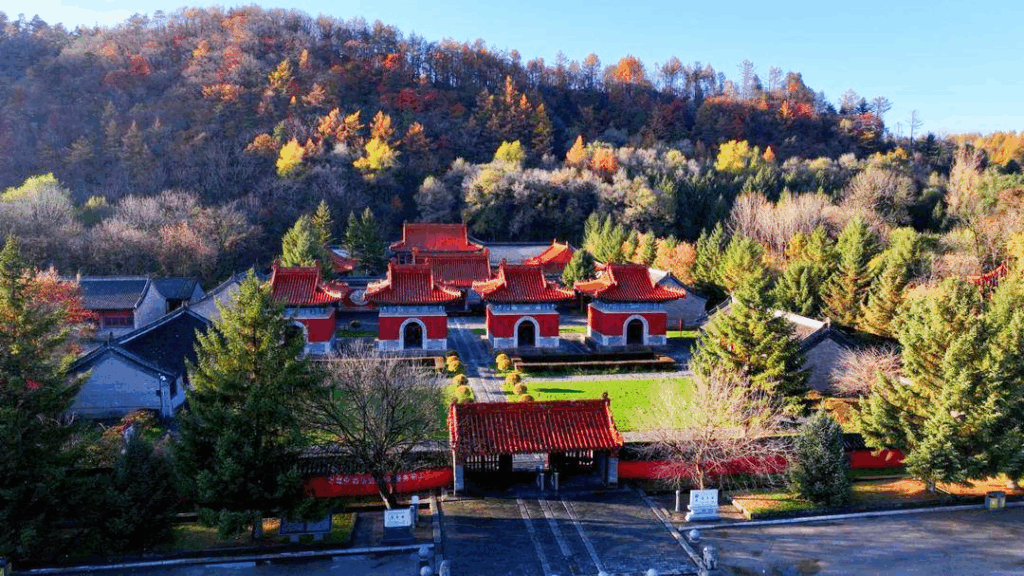
An Essential Guide to Visiting Yongling Mausoleum
Nestled in the heart of Chengdu, the Yongling Mausoleum stands as a remarkable testament to the rich history of the Shu Dynasty. This imperial tomb, the resting place of Wang Jian, the founder of the Shu Kingdom, offers an enchanting glimpse into a bygone era. Unlike other mausoleums that often lay hidden beneath layers of earth, Yongling is uniquely situated above ground, crowned by a serene mound adorned with pine trees that whisper the tales of ancient zither musicians who once played here.
Discovered in 1942 during the construction of air raid shelters, this site is a treasure trove of archaeological wonders. Visitors are greeted by a majestic royal pathway lined with eight intricate figures that lead to a burial chamber steeped in mystique. Within, a replica statue of Emperor Wang Jian watches over an intricately designed coffin, shackled to its base, surrounded by sacred carvings that narrate the emperor’s storied past.
But the experience doesn’t end there. Just a stone’s throw away lies the Yong Ling Museum, where a plethora of artifacts unearthed from the tomb await discovery. From the emperor’s jade belt to silver sacred vessels, each item tells a story of its own, beckoning history enthusiasts and casual visitors alike to delve deeper into the narrative of the Shu Dynasty.
As you wander through the lush gardens and contemplate the rich history enveloping this site, the Yongling Mausoleum invites you to step back in time and explore the legacies of one of China’s lesser-known yet fascinating dynasties. Prepare to be captivated by the beauty and solemnity of this unique cultural landmark, a must-visit for anyone journeying through Chengdu.
In This Guide
- An Essential Guide to Visiting Yongling Mausoleum
- The Rich History and Legends of Yongling Mausoleum
- Main Highlights: What You Absolutely Can’t Miss
- Planning Your Visit: A Practical Guide
- Tickets: Prices, Booking, and Tips
- How to Get There: A Complete Transportation Guide
- Local Cuisine and Accommodation Nearby
- Frequently Asked Questions
- Final Thoughts on Your Trip
The Rich History and Legends of Yongling Mausoleum
Nestled in the heart of Chengdu, the Yongling Mausoleum (永陵) stands as a testament to the rich history and cultural heritage of the Shu Dynasty. This unique imperial tomb is the final resting place of Wang Jian, the founder of the Shu Kingdom, who ruled from 847 to 918 AD. Unlike other grand mausoleums, Yongling is distinctive in that it was constructed above ground, a feature that adds to its historical intrigue.
Discovered only in 1942 during excavation efforts for air raid shelters, the mausoleum’s unearthing revealed a remarkable structure layered with history and artistry. The tomb is set beneath a serene mound that is now blanketed in pine trees, a site once believed to be sacred where zither musicians played. This enchanting backdrop enhances the mausoleum’s allure, allowing visitors to feel the echoes of a bygone era.
As you approach the mausoleum, you will be greeted by a royal way adorned with eight intricately carved figures, symbolizing the path to the afterlife. The entrance leads to a gently sloping ramp that takes you into the burial chamber. Here, a replica statue of Emperor Wang Jian rests behind the coffin plinth, which intriguingly appears to be shackled to its base, suggesting a deep-rooted belief in protection even in death. The base of the plinth is adorned with intricate carvings that illustrate sacred motifs, inviting contemplation of the spiritual beliefs of the time.
Adjacent to the mausoleum lies the Yong Ling Museum, which houses a treasure trove of artifacts excavated from the site. Admission to the museum is included in the entrance fee, making it an essential part of your visit. Here, you can marvel at the remnants of Wang Jian’s life, including a jade belt, a seal, and exquisite silver vessels, including a bowl and an ornamental pig. A poignant exhibit features a headless statue of Wang Jian’s wife and the bearers of his coffin, providing a glimpse into the rituals and customs surrounding death in the Shu Dynasty.
The lush gardens that encircle the mausoleum offer a tranquil escape, while a nearby temple and bell add to the spiritual ambiance. The area’s significance is further highlighted by a collection of statues depicting musicians, reinforcing the cultural importance of music in ancient Shu society.
For international travelers, the Yongling Mausoleum is more than just a historical site; it is a journey back in time. With informative displays in English throughout the museum and beautiful gardens to wander, it offers an enriching experience. Just be sure to grab a guidebook at the entrance, as the free illustrated version is only available in Chinese. Photography is allowed, so don’t forget to capture the serene beauty of this unique mausoleum and its surroundings.
Allow yourself at least three hours to fully explore all the facets of this remarkable site. The stories embedded within its walls and the legends of its past await to be discovered, making the Yongling Mausoleum a must-visit for those seeking to delve into the rich tapestry of Chinese history.
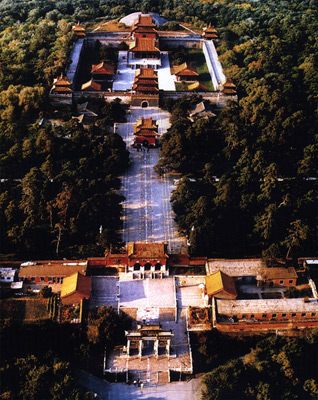
Yongling Mausoleum.
Main Highlights: What You Absolutely Can’t Miss
Visiting the Yongling Mausoleum is an extraordinary journey into the ancient history of the Shu Dynasty, offering a unique glimpse into the life and legacy of Emperor Wang Jian. Here are the main highlights that you absolutely cannot miss during your visit:
The Tomb of Emperor Wang Jian
Nestled within a serene landscape, the Yongling Mausoleum is the final resting place of Wang Jian, the founder of the Shu Kingdom, who reigned from 847 to 918 AD. It is notable for being the only imperial mausoleum constructed above ground, making it a remarkable site of historical significance. As you approach, look for the mound of earth crowned with pine trees, which was once revered as a sacred hill where zither musicians performed.
The Royal Way
As you make your way to the main entrance, you’ll encounter the Royal Way, marked by eight striking stone figures. Each figure has its own story, contributing to the mystique and grandeur of the mausoleum. This pathway sets the tone for the historical journey that lies ahead.
The Burial Chamber
Upon entering the mausoleum, you will ascend an upward ramp before descending into the burial chamber. Here, a replica statue of Emperor Wang Jian, positioned behind the coffin plinth, captures the essence of the emperor’s regal presence. The intricately carved base of the coffin, which appears to be shackled, adds an air of mystery to the site, provoking thoughts about the afterlife beliefs of the Shu Dynasty.
The Exhibition Hall
On your exit, don’t miss the adjacent exhibition hall. It provides an excellent overview of the mausoleum’s history, with informative displays and a cutaway scale replica of the tomb. This space serves as a perfect introduction to the artifacts you will encounter in the museum.
Yong Ling Museum
Behind the mausoleum lies the Yong Ling Museum, included in your entrance ticket (¥20). This museum houses a treasure trove of artifacts excavated from the tomb, including a statue of the emperor, a headless statue of his wife, and various sacred vessels crafted in silver. Notably, the emperor’s jade belt and seal are on display, showcasing the intricate craftsmanship of the era. Be sure to dedicate time to explore this museum, as it provides invaluable context to the history and culture of the Shu Dynasty.
The Surrounding Gardens
Surrounding the mausoleum are beautifully landscaped gardens, perfect for a leisurely stroll. Enjoy the peaceful ambiance as you take in the sights of temples and a bell, which are well worth a visit.
Statues and Artistic Displays
As you exit the park, be sure to check out the reconstructions of musicians and the Emperor’s seal, strategically positioned as a centerpiece. These artistic representations further enrich the site’s cultural significance.
Final Tips
Photography is allowed throughout the mausoleum and museum, so be sure to capture the stunning architecture and artifacts. A free illustrated guidebook is available at the entrance, though it’s primarily in Chinese, so consider downloading translation apps to enhance your understanding of the displays.
Allocate at least three hours to fully experience the mausoleum and museum, and prepare to be transported back in time to the era of the Shu Dynasty. The Yongling Mausoleum is not just a site of historical interest; it’s a profound journey into the past that resonates with the stories of ancient China.
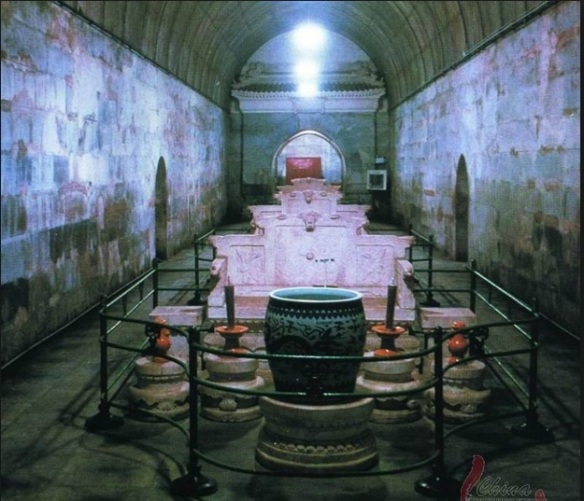
Yongling Mausoleum.
Planning Your Visit: A Practical Guide
When planning your visit to the Yongling Mausoleum, also known as the Tomb of Wang Jian, there are several key aspects to consider to ensure an enriching experience at this historical site, which is both a testament to ancient Chinese culture and an intriguing archaeological discovery.
Getting There
The Yongling Mausoleum is conveniently located in Chengdu, the capital of Sichuan Province, making it easily accessible via public transportation. You can take a taxi or use local buses to reach the site, which is situated just a short distance from the city center. If you’re using a navigation app, input “Yongling Mausoleum” or “Tomb of Wang Jian” for the best directions.
Opening Hours and Admission
The mausoleum is typically open to visitors from 8:00 AM to 6:00 PM, but it’s wise to check for any seasonal variations or public holidays that may affect these hours. The entrance fee is a modest ¥20, which includes access to the adjacent Yong Ling Museum, showcasing artifacts excavated from the site.
What to Expect
Allocate at least three hours for your visit to fully appreciate both the mausoleum and the museum. The mausoleum itself features a scenic royal path lined with eight figures leading to the entrance, where you’ll encounter a unique upward ramp that descends into the burial chamber. Here, a replica statue of Emperor Wang Jian can be found behind the coffin plinth, adding a poignant touch to the site.
After exploring the mausoleum, don’t miss the Yong Ling Museum located behind it. This museum houses an impressive collection of artifacts, including a jade belt and seal belonging to the emperor, as well as sacred vessels and the headless statue of his wife. There is an English-language briefing available, but a free guidebook is only available in Chinese, so consider downloading a translation app for assistance.
Surrounding Attractions
The area around the mausoleum is beautifully landscaped with gardens, temples, and a bell tower. Take time to stroll through the gardens for a peaceful experience amidst the historical backdrop. Additionally, there are reconstructions of musicians’ statues and the emperor’s seal outside the park that make for excellent photo opportunities.
Photography
Feel free to take photographs in all areas of the site, capturing the unique architecture and serene landscapes. The intricate carvings and tranquil surroundings provide many opportunities for stunning shots.
Tips for Your Visit
- Wear comfortable shoes: The site involves some walking, including ramps and gardens.
- Check the weather: Chengdu can be humid or rainy, so dress appropriately and consider bringing an umbrella.
- Plan for lunch: There are several local restaurants nearby that offer authentic Sichuan cuisine. Trying the local food is a must!
- Stay informed: Good information is available in English throughout the museum, but having a translation app on hand can enhance your understanding of the exhibits.
Conclusion
Visiting the Yongling Mausoleum is not just about witnessing the resting place of a significant historical figure; it’s about immersing yourself in the rich tapestry of ancient Chinese history. With thoughtful planning, your trip to this unique imperial tomb will be both enjoyable and enlightening.
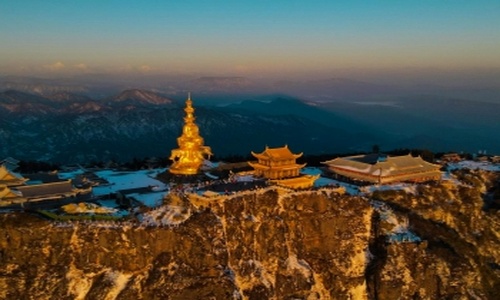
Yongling Mausoleum.
Tickets: Prices, Booking, and Tips
Visiting the Yongling Mausoleum, the final resting place of Wang Jian, the Emperor of Shu, is a journey into the rich tapestry of Chinese history. The mausoleum, unique in its above-ground construction, is not just a significant historical site but also a beautiful cultural experience. Here’s what you need to know about tickets, pricing, and some helpful tips to enhance your visit.
Ticket Pricing and Booking
Admission to the Yongling Mausoleum is quite affordable, with tickets priced at ¥20 (approximately $3 USD) per person. This ticket not only grants you access to the mausoleum itself but also includes entry to the Yong Ling Museum, where you can explore a fascinating collection of artifacts unearthed from the site, including sacred vessels and the emperor’s jade belt.
Tickets can be purchased directly at the entrance. Look for the ticket office to the left of the main entrance; it might not be immediately obvious, so keep an eye out. As the site can get busy, especially during weekends and holidays, it’s advisable to arrive early to avoid long queues.
Visitor Tips
– Plan for Time: Allocate at least three hours to fully explore both the mausoleum and the museum. The surrounding gardens and nearby temple also provide a serene space for reflection and enjoyment.
-
Guided Information: While there is a free illustrated guidebook available at the museum entrance, it is only in Chinese. However, good informational signage in English throughout the museum will help you navigate the exhibits.
-
Photography: Feel free to capture the beauty of the mausoleum and its surroundings as photography is allowed in all areas. Just be mindful of other visitors while doing so.
-
Accessing the Museum: The Yong Ling Museum is located behind the mausoleum and can be accessed via a marble bridge. Make sure not to miss it as it houses valuable historical artifacts, including a replica statue of the emperor.
-
Enjoy the Gardens: The gardens surrounding the mausoleum are lovely and provide a peaceful atmosphere to unwind after your visit. Look out for the statues of musicians that commemorate the site’s historical significance.
By keeping these tips in mind, your visit to the Yongling Mausoleum will be not just informative but also enjoyable, leaving you with lasting memories of this unique slice of Chinese history.
How to Get There: A Complete Transportation Guide
Getting to the Yongling Mausoleum, nestled in Chengdu, is a breeze thanks to the city’s efficient transportation system. Here’s how you can make your journey to this fascinating historical site as smooth as possible.
By Air
Chengdu Shuangliu International Airport (CTU) is the nearest airport, located approximately 20 kilometers (12 miles) from the mausoleum. International travelers will find numerous direct flights to Chengdu from major cities around the world.
From the Airport:
– Taxi: A taxi ride will take about 30-40 minutes, depending on traffic. Expect to pay around ¥70-100.
– Airport Shuttle: You can take the airport shuttle bus to the city center and then switch to a taxi or public transportation to reach the mausoleum.
By Train
Chengdu has two major train stations: Chengdu Railway Station and Chengdu East Railway Station.
- From Chengdu Railway Station:
-
Take Metro Line 1 (the red line) towards Tianfu Square, then transfer to Metro Line 4 (the blue line) at Tianfu Square and head towards Chadianzi. Get off at Yongling station (approximately 30 minutes total).
-
From Chengdu East Railway Station:
- Take Metro Line 2 (the blue line) towards Shijicheng and transfer to Line 1 at Tianfu Square. Follow the same directions as above to reach Yongling station.
By Metro
The Chengdu Metro is a convenient and cost-effective option.
- Metro Line 4: The closest station to Yongling Mausoleum is Yongling Station. Upon exiting, it’s just a short walk to the mausoleum entrance.
By Bus
Chengdu’s public bus network is extensive and can take you close to the mausoleum.
- Look for buses that stop at Yongling Mausoleum or nearby stops. Bus routes 1, 19, and 82 are commonly used to access the area.
By Taxi
Taxis are widely available throughout Chengdu and offer a comfortable way to reach Yongling Mausoleum, especially if you prefer not to navigate public transport.
- Hailing a Taxi: Use ride-hailing apps like DiDi or grab a taxi from designated taxi stands. The ride from the city center will take about 15-20 minutes.
By Bicycle
For the adventurous traveler, renting a bicycle can be a delightful way to explore Chengdu’s charming streets.
- Bike Rentals: Look for bike-sharing services like Mobike or Ofo, which are convenient and cost-effective. The mausoleum is located in a park-like area, making for a pleasant cycling experience.
Final Tips
- Entrance Fee: The entrance fee for the Yongling Mausoleum is ¥20, which includes access to the associated museum where you can see various artifacts.
- Plan Your Visit: Allow at least three hours to fully enjoy the mausoleum and the surrounding gardens.
- Photography: Photography is permitted, so bring your camera to capture the stunning architecture and lush surroundings.
- Language: While some information is available in English, consider downloading translation apps to enhance your experience.
With this comprehensive transportation guide, you’re well-equipped to embark on your journey to the Yongling Mausoleum, immersing yourself in the rich history of the Shu Dynasty. Enjoy your visit!
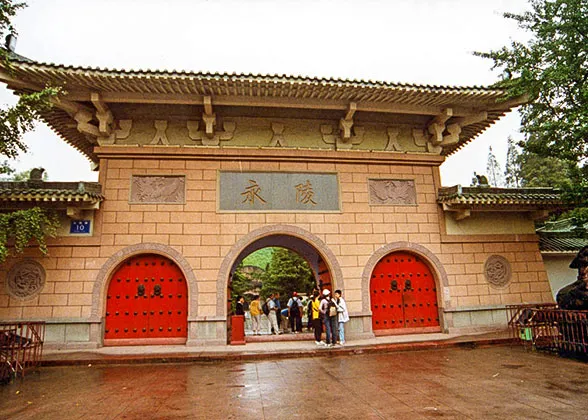
Yongling Mausoleum.
Local Cuisine and Accommodation Nearby
When visiting the Yongling Mausoleum, exploring the local cuisine and finding suitable accommodations can enhance your travel experience in Chengdu. Here are some delightful options to consider:
Culinary Delights
-
Liao PaiGu (YongLing Road)
Located just a short walk from the mausoleum, this restaurant is known for its succulent pork ribs, offering a delicious taste of local Sichuan cuisine. The cozy atmosphere makes it a perfect spot to unwind after your visit. -
YiPin ZhouDian (San DongQiao)
This eatery specializes in traditional Chinese breakfast items, including rice porridge and various dumplings. It’s a great place to fuel up before a day of sightseeing or after exploring the mausoleum. -
ZiGong TeSe Guan
A fantastic choice for those looking to dive into authentic Sichuan flavors, this restaurant serves a variety of spicy dishes that showcase the bold culinary heritage of the region. Make sure to try their famous hot pot! -
Avatar Restaurant
Known for its Xinjiang-style dishes, Avatar offers a unique twist on traditional Chinese cuisine. The ambiance is vibrant, and the menu includes a range of grilled meats and flavorful rice dishes. -
BeiJing Lao QianMen KaoYa
Just a stone’s throw from the mausoleum, this restaurant is famous for its Peking duck. It’s a delightful spot for those looking to experience a different aspect of Chinese culinary art.
Comfortable Stays
-
The Ritz-Carlton, Chengdu
For travelers seeking luxury, this five-star hotel combines modern comforts with traditional Sichuan hospitality. Located a short drive from the mausoleum, it features plush rooms, a spa, and exquisite dining options. -
Shangri-La Hotel, Chengdu
This upscale hotel offers a blend of elegance and convenience, with spacious rooms and splendid views of the city. The hotel’s location makes it easy to access various attractions, including the Yongling Mausoleum. -
Hanting Express Chengdu Yongling
A more budget-friendly option, this hotel provides clean and comfortable accommodations, making it a great choice for travelers who want to keep costs down while still enjoying proximity to the mausoleum. -
Chengdu Flipflop Lounge Hostel
Ideal for backpackers and those looking for a social atmosphere, this hostel offers dormitory-style and private rooms at affordable rates. It’s a fun place to meet fellow travelers and share experiences after a day of exploration. -
Xingyu Hotel
Located conveniently near the mausoleum, this hotel offers basic yet comfortable rooms at reasonable prices. The staff is friendly, and the location allows easy access to local dining options.
Visiting the Yongling Mausoleum is not just a journey into history; it can also be a culinary adventure and a comfortable retreat at the end of the day. Enjoy your explorations in Chengdu!
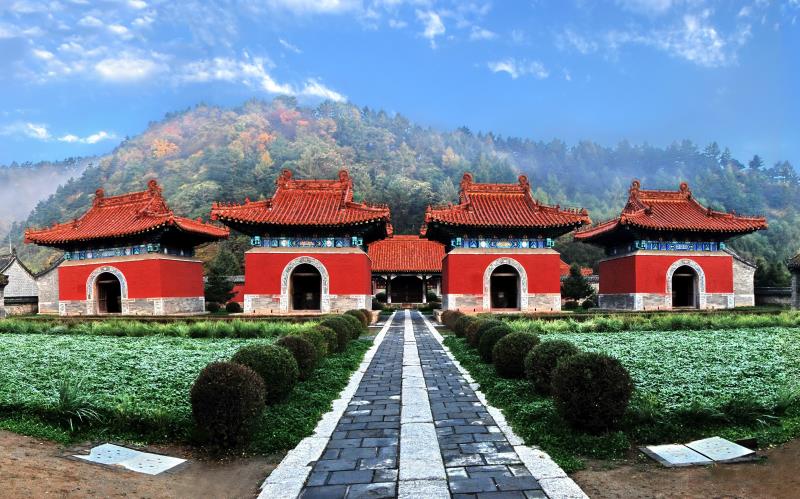
Yongling Mausoleum.
Frequently Asked Questions
Frequently Asked Questions about Yongling Mausoleum
-
What is the Yongling Mausoleum and why is it significant?
The Yongling Mausoleum is the tomb of Wang Jian, the Emperor of the Shu Dynasty (847-918 AD). It is unique as the only imperial mausoleum built above ground and was uncovered in 1942. This historical site is a window into ancient Chinese burial practices and the history of the Shu Dynasty. -
How do I get to the Yongling Mausoleum?
The mausoleum is located in Chengdu, easily accessible by public transport, taxi, or even by walking from nearby attractions. Make sure to check local transport apps or maps for the best route. -
What are the entrance fees and hours of operation?
Admission to the Yongling Mausoleum is ¥20, which also includes access to the Yong Ling Museum. The mausoleum is open daily, but it’s advisable to check the specific hours before your visit, as they may vary seasonally. -
How much time should I allocate for my visit?
Plan to spend at least three hours to fully explore the mausoleum and museum. This will allow you to appreciate the intricate carvings, statues, and the surrounding gardens. -
Is photography allowed at the mausoleum?
Yes, photography is permitted throughout the mausoleum and its grounds. However, be respectful of other visitors and the historical significance of the site. -
Are there any guided tours available?
While there may not be formal guided tours, the museum provides good informational signage in English to help you navigate the site. A free illustrated guidebook is available, though it is in Chinese. -
What can I see in the Yong Ling Museum?
The museum houses various artifacts excavated from the tomb, including sacred vessels, a jade belt, and a replica statue of Emperor Wang Jian. It’s a fascinating complement to the mausoleum that provides deeper insights into the era. -
Are there any facilities available on-site?
Yes, there are basic facilities such as restrooms and a ticket office. Additionally, the area features beautiful gardens, a temple, and a bell that are worth exploring after your visit to the mausoleum and museum.
Final Thoughts on Your Trip
As your journey through Chengdu comes to an end, the Yongling Mausoleum, the final resting place of Wang Jian, stands as a poignant reminder of China’s rich history and cultural heritage. This unique imperial tomb, nestled amidst serene gardens and ancient pine trees, invites you to reflect on the artistry and craftsmanship of the Shu Dynasty.
Wandering through the mausoleum and its accompanying museum, you are not just observing artifacts; you are stepping back in time, connecting with the stories of a bygone era. The intricate carvings, sacred vessels, and the replicated statue of the emperor tell tales of reverence and legacy that resonate deeply within these walls.
Don’t forget to take a moment to enjoy the tranquil surroundings and the beauty of the gardens, where the echoes of zither melodies once filled the air. As you leave, consider how the Yongling Mausoleum is not just a historical site but a gateway to understanding the complexities and richness of Chinese culture.
So, as you bid farewell to this remarkable landmark, carry with you the memory of its timeless beauty and the stories that linger in the air. Your visit to Yongling Mausoleum will surely enrich your journey through Chengdu and beyond, inspiring you to seek out more hidden gems that hold the echo of history in every stone. Safe travels!